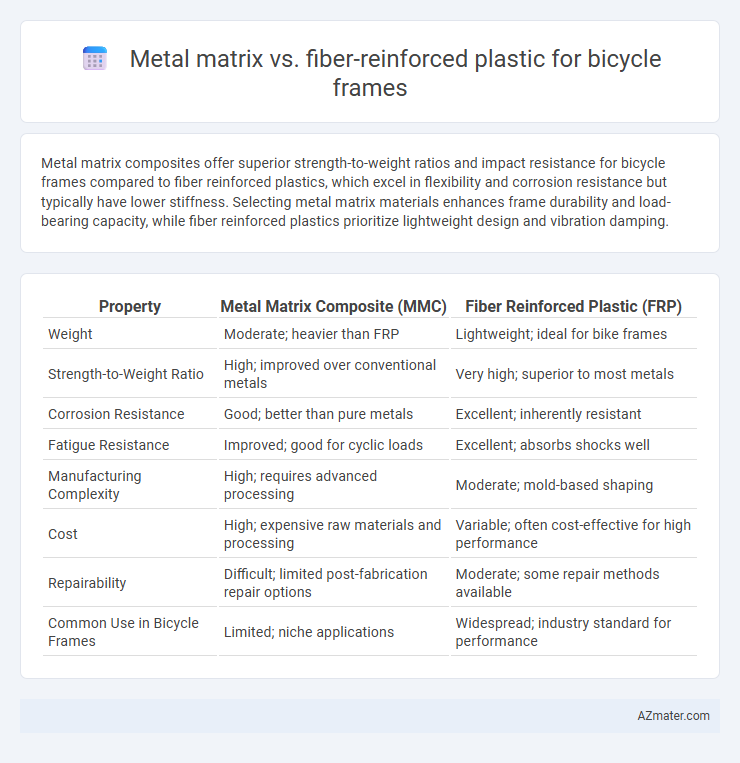Metal matrix composites offer superior strength-to-weight ratios and impact resistance for bicycle frames compared to fiber reinforced plastics, which excel in flexibility and corrosion resistance but typically have lower stiffness. Selecting metal matrix materials enhances frame durability and load-bearing capacity, while fiber reinforced plastics prioritize lightweight design and vibration damping.
Table of Comparison
| Property | Metal Matrix Composite (MMC) | Fiber Reinforced Plastic (FRP) |
|---|---|---|
| Weight | Moderate; heavier than FRP | Lightweight; ideal for bike frames |
| Strength-to-Weight Ratio | High; improved over conventional metals | Very high; superior to most metals |
| Corrosion Resistance | Good; better than pure metals | Excellent; inherently resistant |
| Fatigue Resistance | Improved; good for cyclic loads | Excellent; absorbs shocks well |
| Manufacturing Complexity | High; requires advanced processing | Moderate; mold-based shaping |
| Cost | High; expensive raw materials and processing | Variable; often cost-effective for high performance |
| Repairability | Difficult; limited post-fabrication repair options | Moderate; some repair methods available |
| Common Use in Bicycle Frames | Limited; niche applications | Widespread; industry standard for performance |
Introduction to Bicycle Frame Materials
Metal matrix composites offer exceptional strength-to-weight ratios and enhanced stiffness, making them suitable for high-performance bicycle frames that demand durability and shock resistance. Fiber reinforced plastics, such as carbon fiber composites, provide superior lightweight characteristics and excellent vibration damping, ideal for competitive cycling and comfort. Both materials push technological boundaries in bicycle frame manufacturing by optimizing strength, weight, and ride quality.
Understanding Metal Matrix Composites
Metal matrix composites (MMCs) offer enhanced strength-to-weight ratios and improved thermal conductivity compared to fiber reinforced plastics (FRPs) for bicycle frames. MMCs integrate ceramic or ceramic-like fibers within a lightweight metal such as aluminum or titanium, resulting in superior stiffness and impact resistance while maintaining corrosion resistance. These properties make MMCs particularly advantageous for high-performance bicycles requiring durability and lightweight construction.
Overview of Fiber Reinforced Plastic Composites
Fiber reinforced plastic (FRP) composites combine a polymer matrix with high-strength fibers such as carbon, glass, or aramid, delivering exceptional strength-to-weight ratios ideal for bicycle frames. These composites offer superior fatigue resistance, corrosion resistance, and customizable stiffness compared to traditional metal matrices. Advanced FRP materials enhance ride comfort and performance by absorbing vibrations and enabling tailored frame geometry designs, making them increasingly popular in high-performance cycling applications.
Weight Comparison: Metal Matrix vs Fiber Reinforced Plastic
Fiber reinforced plastic (FRP) bicycle frames typically offer a significant weight advantage over metal matrix frames, with FRP materials such as carbon fiber composites being up to 30-50% lighter than aluminum or steel matrices. Metal matrix composites (MMC) provide enhanced strength and stiffness but often at the cost of increased weight, typically ranging from 2.5 to 4 kg for frames compared to 1 to 2.5 kg for high-quality fiber reinforced plastic frames. Weight efficiency in FRP frames contributes to improved acceleration and handling, making them a preferred choice for performance-focused cycling applications.
Strength and Durability Assessment
Metal matrix composites for bicycle frames offer superior tensile strength and impact resistance compared to fiber reinforced plastics, enhancing load-bearing capacity and durability under dynamic stresses. Fiber reinforced plastics provide excellent fatigue resistance and corrosion immunity, contributing to long-term structural integrity and weight efficiency. Strength assessment shows metal matrices outperform in stiffness and crack resistance, while fiber reinforced plastics excel in flexibility and resilience against cyclic fatigue.
Ride Quality and Vibration Damping
Metal matrix composites in bicycle frames offer superior stiffness and strength but often transmit higher vibration levels to the rider, compromising ride comfort. Fiber reinforced plastics excel in vibration damping due to their anisotropic fiber structures, effectively absorbing road shocks and enhancing ride quality. Consequently, fiber reinforced plastic frames provide a smoother and more comfortable cycling experience compared to metal matrix alternatives.
Corrosion and Environmental Resistance
Metal matrix composites for bicycle frames offer high strength but are prone to corrosion, especially aluminum alloys, requiring protective coatings to enhance durability. Fiber reinforced plastics (FRP), such as carbon fiber composites, exhibit excellent corrosion resistance and environmental stability, making them highly suitable for wet and humid conditions. The inherent corrosion resistance of FRP reduces maintenance needs and extends frame lifespan compared to metal matrix alternatives.
Manufacturing Processes and Cost Implications
Metal matrix composites (MMCs) for bicycle frames involve complex manufacturing processes such as powder metallurgy, casting, and forging, which require high-temperature equipment and precise control, leading to increased production costs. Fiber reinforced plastics (FRPs) use methods like filament winding, lay-up, and resin transfer molding that offer greater design flexibility and lower tooling expenses, making them more cost-effective for custom or small-batch frames. Despite the higher initial investment for MMC production, the durability and wear resistance can reduce long-term maintenance costs, while FRPs emphasize lightweight performance with moderate upfront manufacturing expenditures.
Sustainability and Recycling Considerations
Metal matrix composites offer excellent durability and are highly recyclable, with established metal recycling infrastructures that reduce environmental impact. Fiber reinforced plastics provide lightweight and high-performance alternatives but face challenges in recycling due to complex resin-fiber separation processes, often leading to landfill disposal or downcycling. Sustainable bicycle frame design increasingly emphasizes metal matrices for circular economy benefits while ongoing advancements in thermoplastic composites aim to improve fiber reinforced plastic recyclability.
Choosing the Best Material for Performance and Comfort
Metal matrix composites offer high strength and excellent fatigue resistance, making them ideal for enhancing bicycle frame durability and performance. Fiber reinforced plastics provide superior vibration damping and lightweight properties, significantly improving rider comfort and maneuverability. Selecting the best material depends on balancing the demands for stiffness, weight reduction, and shock absorption tailored to specific cycling styles and terrains.

Infographic: Metal matrix vs Fiber reinforced plastic for Bicycle frame
 azmater.com
azmater.com